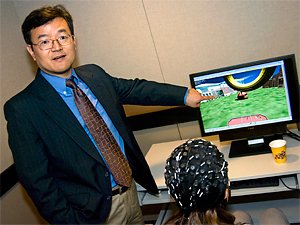Professor reveals new milestone in mind control

New technology lets people's thoughts steer virtual objects in 3-D
Seated before a computer screen, Elissa Gutterman does what once seemed impossible: She guides a helicopter through virtual 3-D space by the force of her thoughts.
Watching her move the helicopter is fun, but biomedical engineering professor Bin He has a serious purpose in mind. He hopes that someday his work on brain-computer interfaces will give some control over their environment to people who have only their minds with which to communicate. Stroke and paralysis survivors are among the potential beneficiaries.
This is the first time, to He's knowledge, anyone has demonstrated a system that allows a person to continuously move objects on a screen at will through 3-D space using noninvasive technology. And the system's noninvasive character means it could have implications far beyond the hospital. It could possibly help people drive or navigate, or it may find a use in entertainment software.
"Our dream is to develop a way to integrate brain and machine to help patients and give everyone a better life," says He.
The concept is simple. Embedded in the cap Gutterman wears are 64 electrodes picking up EEG signals from her cerebral cortex. To move the helicopter, she will, for example, think about moving one side of her body. This generates neural activity that is translated to a command to move the helicopter in the same direction.
In the video accompanying this article, you'll see Gutterman steer the helicopter over a virtual landscape representing the Northrop Mall area of the University of Minnesota Twin Cities campus. The goal is to guide the chopper through the big gold ring hovering over the greensward.
The new system demonstrates new capabilities that "nobody ever thought about before," says He.
